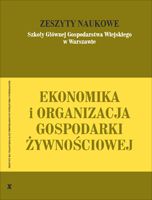Main Article Content
Article Details
AKROYD S., SMITH L., 2007: Review of Public Spending to Agriculture. A joint DFID / World Bank study. Main Study & Country Case Studies. Final draft, Oxford Policy Management, Oxford.
BIRNER R., RESNICK D., 2010: The Political Economy of Policies for Smallholder Agriculture, World Development 38(10), 1442–1452. https://doi.org/10.1016/j.worlddev.2010.06.001
CZYŻEWSKI A., MATUSZCZAK A., 2014: Krajowe i unijne wydatki budżetowe na sektor rolny w Polsce, Roczniki Naukowe Ekonomii Rolnictwa i Rozwoju Obszarów Wiejskich 101(2), 37–44.
DASTAGIRI M.B., 2010: The Effect of Government Expenditure on Promoting Livestock GDP and Reducing Rural Poverty in India, Outlook on Agriculture 39(2), 127–133. https://doi.org/10.5367/000000010791745402
DASTAGIRI M.B., VAJRALA A.S., 2018: The Political Economy of Global Agriculture: Effects on Agriculture, Farmers, Consumers and Economic Growth, European Scientific Journal 14(4), 193–222. https://doi.org/10.19044/esj.2018.v14n4p193
DIAKOSAVVAS D., 1990: Government Expenditure on Agriculture and Agricultural Performance in Development Countries: an Empirical Evaluation, Journal of Agricultural Economics 41(3), 381–390.
ELIAS V., 1985: Government Expenditures on Agriculture and Agricultural Growth in Latin America, Research Report 50, International Food Policy Research Institute, Washington.
FAN S., HAZELL P., THORAT S., 2000: Government Spending, Agricultural Growth and Poverty in Rural India, American Journal of Agricultural Economics 82(4), 1038–1051. https://doi.org/10.1111/0002-9092.00101
FAN S., RAO N., 2003: Public Spending in Developing Countries: Trends, Determination, and Impact, EPTD Discussion Papers 99, International Food Policy Research Institute, Washington.
FAN S., ZHANG X., 2008: Public Expenditure, Growth and Poverty Reduction in Rural Uganda, African Development Review 20(3), 466–496. https://doi.org/10.1111/j.1467-8268.2008.00194.x
FISCHER T.R., BYERLEE D., EDMEADES G., 2009: Can Technology Deliver on the Yield Challenge to 2050, [in] Paper prepared for the Expert Meeting on How to Feed the World in 2050, Food and Agriculture Organization of the United Nations, Rome.
Food and Agriculture Organization of the United Nations, 2012: The State of Food and Agriculture, Investing in Agriculture for a Better Future, Rome.
Food and Agriculture Organization of the United Nations, 2018: World Food and Agriculture Statistical Pocketbook, Rome.
GDAKOWICZ A., 2014: The Application of Japanese Candlestick Charting on the Residential Real Estate Market, Real Estate Management and Valuation 22(4), 27–34. https://doi.org/10.2478/remav-2014-0034
GOLLIN D., PARENTE S., ROGERSON R., 2002: The Role of Agriculture in Development, American Economic Review 92(2), 160–164. https://doi.org/10.1257/000282802320189177
GOYAL A., NASH J., 2016: Reaping Richer Returns, Preliminary Overview: Public Spending Priorities for African Agriculture Productivity Growth, World Bank, Washington DC.MARSHALL B.R., YOUNG M.R., ROSE L.C., 2006: Candlestick Technical Trading Strategies: Can They Create Value for Investors, Journal of Banking & Finance 30(8), 2303–2323. https://doi.org/10.1016/j.jbankfin.2005.08.001
MARTIN W., WARR P.G., 1990: The Declining Economic Importance of Agriculture, National Centre for Development Studies and Department of Economics, Research School of Pacific Studies, Australian National University.
MELLOR J.W., 2008: Agriculture and Development, [in:] The New Palgrave Dictionary of Economics, 2nd ed., Vol. 1, Macmillan Publishers, New York.
MILLS S., ABOUZAHR C., KIM J., RASSEKH B.M., SARPONG D., 2017: Civil Registration and Vital Statistics (CRVS) for Monitoring the Sustainable Development Goals (SDGs), Paper prepared for the eLearning course on Civil Registration & Vital Statistics Systems.
MOGUES T., 2012: What Determines Public Expenditure Allocations? A Review of Theories and Implications for Agricultural Public Investment, SEA Working paper 12-06, Food and Agriculture Organization of the United Nations, Rome.
MOGUES T., YU D., FAN S., MCBRIDE L., 2012: The Impacts of Public Investment in and for Agriculture: Synthesis of the Existing Evidence, ESA Working paper 12-07, Food and Agriculture Organization of the United Nations, Rome.
NISON S., 1994: Beyond Candlesticks: New Japanese Charting Techniques Revealed, Wiley Finance, New York.
SHETTY S.L., 1990: Investment in Agriculture: Brief Review of Recent Trends, Economic and Political Weekly 25(7/8), 389–398.
SYED S., MIYAZAKO M., 2013: Promoting Investment in Agriculture for Increased Production and Productivity, Food and Agriculture Organization of the United Nations, Rome.
TSAKOK I., GARDNER B., 2007: Agriculture in Economic Development: Primary Engine of Growth or Chicken and Egg?, American Journal of Agricultural Economics 89(5), 1145–1151. https://doi.org/10.1111/j.1467-8276.2007.01075.x
United Nations, 2015: Transforming our World: the 2030 Agenda for Sustainable Development, Resolution Adopted by the General Assembly on 25 September 2015, A/RES/70/1, United Nations.
WIELECHOWSKI M., 2019: Government Expenditure on Agriculture – a European, Regional and World Perspective, Annals of the Polish Association of Agricultural and Agribusiness Economists 21(4), 561–570. https://doi.org/10.5604/01.3001.0013.5732
World Bank, 2011: Practitioners Toolkit for Agriculture Public Expenditure Analysis, World Bank and U.K. Department for International Development, Washington DC.
ZAWOJSKA A., 2013: The Economic and Social Justifications for Public Spending to Agriculture: Theoretical Insights and Empirical Observations, Acta Scientiarum Polonorum. Oeconomia 12(4), 133–143.
ZVIRBULE-BERZINA A., 2011: The role of enterprise integration in agriculture entrepreneurship. Proceedings of 8th International Conference "Economic Integration, Competition and Cooperation", 6-9 April, Opatija, University of Rijeka – Faculty of Economics. https://doi.org/10.2139/ssrn.2232640
Downloads
- Piotr Kułyk, Mariola Michałowska, Price and readiness to pay for specific ecological products on the example of the inhabitants of the Lubuskie Voivodeship , Zeszyty Naukowe SGGW - Ekonomika i Organizacja Gospodarki Żywnościowej: No. 125 (2019)
You may also start an advanced similarity search for this article.
- Wioleta Sobczak, Michał Wielechowski, Fruit and vegetable producer groups and organizations development in Poland in the light of EU and national legislation , Zeszyty Naukowe SGGW - Ekonomika i Organizacja Gospodarki Żywnościowej: No. 103 (2013)






 Knowledge base
Knowledge base